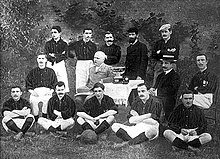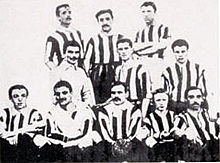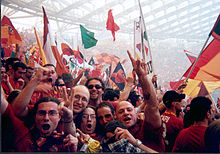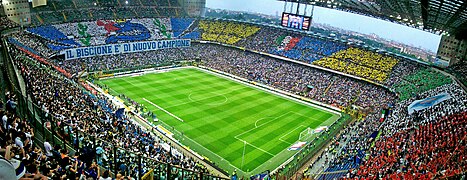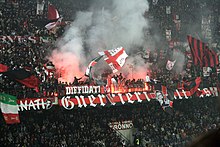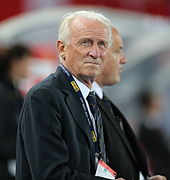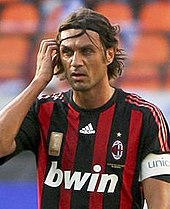Series A
| Series A | |

|
|
| Full name | Lega Nazionale Professionisti Serie A |
| Association | FIGC |
| First edition | 1898 |
| hierarchy | 1st League |
| Teams | 20th |
| master | Juventus Turin |
| Record champions | Juventus Turin ( 36 titles ) |
| Record player |
|
| Record scorer |
|
| Current season | 2020/21 |
| Website | legaseriea.it |
| Qualification for |
UEFA Champions League UEFA Europa League Supercoppa Italiana |
|
↓ Series B (II)
|
|
The Serie A is the highest division in Italian professional football . Your formal name is Lega Nazionale Professionisti Serie A .
The Serie A championship title is colloquially referred to as scudetto (German "small shield " ), after a shield-shaped badge in the Italian national colors that the reigning champion wears on the jersey in the following season .
The most successful participant is Juventus Turin with 36 championships won, followed by AC Milan and Inter Milan with 18 championships each.
Serie A players have been voted European Footballer of the Year 18 times , the most frequently, with Juventus Turin (eight times) and AC Milan players (seven times) being the most frequent. Including four Italian players. Serie A was named the official FIFA World Player of the Year seven times ; previously, a Serie A player was named unofficial World Player of the Year nine times (always).
The organizer of the championship is the Lega Nazionale Professionisti ( German "National Professional League" ), usually simply called Lega Calcio , a sub-organization of the Italian football association Federazione Italiana Giuoco Calcio .
According to the UEFA five-year ranking, Serie A is one of the most important European leagues with the English Premier League , the Spanish Primera División and the German Bundesliga .
The season of the current 2020/21 season starts on September 19, 2020 and ends on May 23, 2021.
Basics
Since the 2004/05 season, the league has consisted of 20 clubs (previously 18). The clubs in the last three places that were so bring the fewest points during the season, rising to the second division, the Series B decreases. Accordingly, the three teams in Serie B (1st and 2nd place and the winner of the play-offs between 3rd and 6th place) advance to Serie A. In the event of a tie between several teams, the direct comparison between these teams is decisive . Until the 2005/06 season, play- offs took place at the end of the season with equal points . Most recently, at the end of the 2004/05 season, FC Parma and FC Bologna played a direct duel against relegation.
The start of the season is the Italian Supercup , which will be held at the end of August. Occasionally, this takes place abroad for advertising purposes. The actual championship usually starts at the beginning of September and lasts until the end of May. After the end of the first half of the season in December, after a short winter break, the second half of the season traditionally begins on January 6th. Each team plays twice during the season against every other team in the league, once in the home stadium and once away, in the opponent's venue.
The Serie A matchday is traditionally Sunday afternoon, but two games are regularly played on Saturday. The top game of the round is usually played on Sunday evening. Sometimes there are English weeks in which games are also played on Tuesdays and Wednesdays.
The champions are the team that are in first position at the end of the 38 game days, that is, they have scored the most points. Due to the position of the Italian league in the UEFA five-year ranking, the first four places qualify for direct participation in the Champions League . Places five and six, as well as winning the Coppa Italia, entitle them to participate in the Europa League .
history
prehistory
Between the introduction of the championship in 1898 until after the 1928 season, the Italian champions were played in a championship round between the winners of the various regional associations, similar to the German system before 1962 . The first Italian championships do not hold up to any current comparison. They were small tournaments that were played on a sunny afternoon. The first Italian championship took place on May 8, 1898 in Turin . Four teams took part: the future champions Genoa CFC and the Turin clubs Internazionale Torino , FC Torinese and Ginnastica Torino .
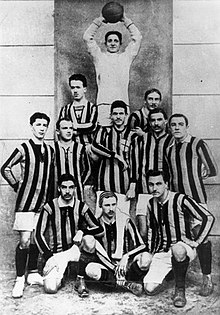
Because of the First World War, the championship round was paused from 1916 to 1919. The game was soon resumed and continued according to the old mode. In the post-war turmoil, however, two football associations claimed the Italian championship title for themselves. In addition to the FIGC , the Confederazione Calcistica Italiana (CCI) was formed in 1919 , in which a championship was also played. However, this federation went back into the FIGC in 1922, so that with the SG Pro Vercelli (CCI) and US Novese (FIGC) there were officially two Italian champions that year.
Soon after the war, interest in football increased enormously, and professional football slowly established itself. The first documented professional soccer player was Virginio Rosetta , who joined Juventus Turin from US Pro Vercelli in 1923 . Edoardo Agnelli brought capital to the Turin association, which enabled the Turinese to transfer Rosetta to Turin for the then record sum of 50,000 lire .
The professionalization of football brought the successes of the then serial winners CFC Genua and US Pro Vercelli to an end. Since 1924, neither Genoa nor Pro Vercelli could achieve a national title at the professional level.
In 1927, the second Turin club, Turin FC , was revoked the title it had already won due to an infraction.
The first years and the Second World War (1929–1949)
At the beginning of the championship in 1929, the game mode was changed. Since then, the champion is no longer determined from among the regional winners, but from all participating teams. The championship was thereby extended, for the first time the championship lasted over the turn of the year. Furthermore, the then Italian dictator Mussolini , who was an avowed football fan, forced the merger of the Milanese clubs Inter Milan and US Milanese into Ambrosiana Inter. The separation takes place immediately after his fall in 1943.
Because of the Second World War , the championship had to be interrupted again between 1944 and 1946. Even if there were no official champions at this time, an unofficial championship was played in 1944, in which the AC Spezia team , which was reinforced with players from the local volunteer fire department , could win the title. The Serie A began regular operations under this name for the first time in 1946. This was accompanied by the establishment of the Lega Calcio , based in Milan . It was constituted for the first time on May 14, 1946. Initially, only an all-Italian professional league emerged; 21 teams took part in this 1947/48; to date it is the highest number of clubs. A subsequent reform founded Serie A and Serie B with 18 teams each. The Serie A has had this name since then.
Il Grande Torino

After the war, AC Turin dominated the Italian championship. The team that came to be known as the “ Grande Torino ” is still sometimes referred to as one of the best teams to have ever played in Serie A. On May 4, 1949, the entire team of the designated champions, AC Turin, with one exception in a plane crash on the Superga hill near Turin. The title was awarded posthumously to the Turinese . This also marked the beginning of the turning point in Italian football. Since then, with a few exceptions, the major Italian clubs mentioned at the beginning have dominated national football. Juventus, Inter and Milan have won the national championship 55 times since World War II.
Since 1956/57 non-Italian referees have been allowed to lead games; In addition, the first live broadcast of a game on television took place that year , but at that time it was brought forward to a Saturday. From today's perspective, the criticism of the then President of the Italian Olympic Committee ( CONI ), Onesti, of the Italian Football League on August 3, 1958 , is very interesting. In it, the President accuses the association of spending far too much money on football. The term “ricchi scemi” (“rich fools”) is also mentioned.
Under the leadership of Aldo Stacchi , radical changes were made in the league from August 1965. From the 1967/68 season, Serie A was reduced from 18 clubs to 16; the increase to 18 teams took place in 1987. The second measure was much more drastic. After the scandalous defeat of the two-time world champions against North Korea at the 1966 World Cup , in order to strengthen the Italian national team and to repeat the Italian successes in the 1930s, no foreigners were allowed to participate in the championship between 1966 and 1980. Two years after the suspension was lifted, Italy became world champions in 1982 . However, this did not prevent some clubs from employing foreigners by naturalizing them. Since May 1980 foreigners have been allowed to take part in the national championship again.
Betting scandal, commercialization and north against south
In 1973 the Football Association asked the National Olympic Committee for more money. The 500–600 billion lire that the association received from funds from the Totocalcio (football betting game ) was no longer enough to fill the 50 billion lire hole (25 million euros) of the clubs. There was no solution in sight, eight years later the betting scandal was just one of the consequences of the clubs and league's debt.
The aforementioned scandal finally occurred in 1980/81 when AC Milan and Lazio Rome were forced to relegate due to illegal betting transactions. The Milanese succeeded in the immediate re-emergence from Serie B , but one year later they got down again before they could establish themselves again in Serie A. The three-man dominance mentioned above was permanently broken in these years, so that other clubs were able to conquer the championship again. In 1983 AS Roma became champions again after more than 40 years and in 1985 Hellas Verona for the first time . The SSC Napoli with Diego Maradona also provided variety from the mid-1980s and interrupted the northern Italian dominance. The Neapolitans won the championship in the 1986/87 and 1989/90 seasons.
Far-reaching changes in funding followed in the 1980s. Since the financial situation of the clubs had improved little, further innovations followed from the 1981/82 season. Since then, sponsorship (such as jersey advertising) has been liberalized and television and broadcasting rights have increasingly become the interests of the league. Until then, the games had been broadcast on RAI public television . Even if the holding company Fininvest made a public offer to the league, the rights initially remained with RAI. The contract was increased by 5.8 billion lire (2.9 million euros). However, the situation did not improve significantly, the debts of the clubs totaled 200 billion lire (100 million euros) in the mid-1980s. In 1990, RAI had to pay 162.5 million euros to extend the contract. After that season, Italian football was no longer on free-to-air television. The financial situation eased slightly as a result of the offers from Italian pay-per-view television. The 1995 Bosman ruling caused a setback. To date, the situation has not improved significantly. In recent years, AC Parma , AC Florence and SSC Naples have had their licenses revoked due to economic difficulties. In 2005 the Italian parliament passed a law according to which clubs can write off losses due to lower transfer values from their taxes over the years.
In sporting terms, championship titles from the Roman clubs Lazio and AS Roma followed at the end of the millennium.
In the summer of 2005, Italian football was again badly shaken. The football association, the Lega Calcio, refused to license several Serie A and Serie B clubs. This affected, among other things, FC Messina and Serie B promoted AC Turin . While the sports court in Rome confirmed the license to the Messina club, which was in debt with 18 million euros, the sports court followed the decision of the Lega Calcio and denied the promotion of AC Turin. The club, which was in debt with 30 million euros, was able to at least save the second division license through new investments by sponsors.
The draconian punishment of the first Italian champion, the CFC Genoa, was of a different nature. Both the league and the sports court saw it as proven that Genoa had bought promotion with at least one rigged game. Genoa's president Enrico Preziosi bought his team's 3-2 victory at the then relegated AC Venice with a cash handover of 250,000 euros. The Lega Calcio then moved Genoa to last place in Serie B, which in fact meant relegation to Serie C1 . Furthermore, Genoa was punished with a point deduction of three points for the next season. The presidents of the two associations were not allowed to hold any offices in their associations for five years.
The Serie B clubs Ascoli Calcio and FBC Treviso benefited from this decision, as they were allowed to move up to Serie A.
Calciopoli scandal, Italian football in crisis
Just a year later, the biggest football scandal in Italian history was exposed. Systematic referee agreements, particularly in the 2004/05 and 2005/06 seasons, were uncovered, in which nine clubs and several commission agents and referees were involved. The decisive mastermind was the then Juventus manager Luciano Moggi , who is considered the coordinator of the affair. The scandal also affected the Serie A clubs AC Milan, AC Florence, Lazio Rome and Reggina Calcio as well as the Serie B club AC Arezzo. In addition to drastic point deductions for the clubs, this led, among other things, to the withdrawal of two championship titles from Juventus and the club's forced relegation, as well as to bans of managers and officials, especially Luciano Moggi, Antonio Giraudo and the referee Massimo De Santis .
The 2006/07 season was also shaken by scandals; individual clubs struggled with serious fanatic riots. The low point was the game Catania Calcio against US Palermo , when a police officer who was deployed died in serious riots with more than a hundred injuries, hit by a washbasin that had previously been torn from a stadium toilet by the rioters. In response, the Italian association canceled not only Serie A but all leagues in the country for the following match day. The friendly match between Italy's national soccer team and Romania on February 7, 2007 was also canceled.
societies
The Italian Serie A has always had a strong north-south divide. The economically stronger north of Italy is also dominant in football. This is shown even more decisively in the successes. With a few exceptions (1956 and 1969 AC Florence , 1970 Cagliari Calcio , 1987 and 1990 SSC Napoli , 1974 and 2000 Lazio Rome , 1983 and 2001 AS Rome ) since 1945 all championship titles have gone to northern Italy, especially to the industrial cities of Turin and Milan .
However, there have been slight shifts in recent years. Ten years ago only three clubs from the south were in the highest Italian league, today there are five. Until the forced relegation of the SSC Naples, it was the representative of the south in the “fight” against the industrial cities of the north. In the 2006/07 season, the US Palermo was particularly convincing. In the following season, however, Napoli returned to Serie A and finished eighth.
Most frequently represented in the 2019/20 season are the regions of Lombardy and Emilia-Romagna , in which four clubs each play ( Atalanta Bergamo , Brescia Calcio , AC Milan and Inter Milan , as well as FC Bologna , US Sassuolo Calcio , Parma Calcio and SPAL ) . Traditional city duels are currently being played in Milan, Rome, Turin and Genoa, where the derbies AC Milan – Inter Milan, AS Roma – Lazio, Juventus Turin – FC Turin and CFC Genoa – Sampdoria Genoa are the highlights of the season. The derby in Verona (Hellas-Chievo) is more recent and less significant nationally. The rest of the clubs are distributed evenly across Italy, without any significant concentration on any particular area.
However, some mostly southern Italian regions such as Abruzzo , Apulia , Calabria and the Marche are, occasionally for decades, without a club in Serie A. The regions of Basilicata and Molise and the autonomous regions of Trentino-Alto Adige and Aosta Valley have never had a representative in the highest Division.
City derbies

Since Serie A was founded in 1929 , there have been five city derbies in the top division of Italian club football .
The most common city derby and one of the most famous football derbies in the world is the match between AC Milan and Inter Milan , which takes place almost every six months. Only between 1943 and 1945, when league operations were suspended for two years due to World War II , and in the 1980/81 and 1982/83 seasons after Milan was sentenced to relegation to Serie B due to a betting scandal . In contrast to many other derbies, the so-called Derby della Madonnina is not characterized by geographical, cultural or political contrasts, but is particularly explosive because Inter Milan emerged from the older AC Milan, both clubs share the stadium and the national and national clubs are equally successful internationally. Milan is the only city that is home to two Champions League winners.
Another almost regular encounter in Serie A is the Roman city derby ( Derby della Capitale ), between AS Roma and Lazio Rome , which is considered the most critical city derby in Serie A and has repeatedly led to clashes between the two ultra groups.
There are other traditional city derbies between Italy's record champions Juventus Turin and FC Turin ( Derby della Mole ), as well as CFC Genoa and Sampdoria Genoa ( Derby della Lanterna ). A derby rare in Serie A is the Derby di Verona between Chievo Verona and Hellas Verona .
In the 2019/20 season of Serie A, there will be two city derbies each in Milan, Turin, Rome and Genoa.
Participating clubs in the 2020/21 season
The following 20 clubs will contest the 2020/21 season in Serie A.
Locations of the participating clubs in the 2020/21 season |
| society | Placement 2019/20 | First season in the top division | Consistently in the top division since | |
|---|---|---|---|---|
|
|
Atalanta Bergamo | 3. | 1928/29 | 2011/12 |
|
|
Benevento Calcio | Master of Series B | 2017/18 | 2020/21 |
|
|
Bologna FC | 12. | 1910/11 | 2015/16 |
|
|
Cagliari Calcio | 14th | 1964/65 | 2016/17 |
|
|
FC Crotone | Series B runner-up | 2016/17 | 2020/21 |
|
|
AC Florence | 10. | 1928/29 | 2004/05 |
|
|
CFC genoa | 17th | 1898 | 2007/08 |
|
|
Sampdoria Genoa | 15th | 1946/47 | 2012/13 |
|
|
AC Milan | 6th | 1899 | 1983/84 |
|
|
Inter Milan | Runner-up | 1908 | 1929/30 |
|
|
SSC Naples | 7th | 1926/27 | 2007/08 |
|
|
Parma Calcio | 11. | 1920/21 | 2018/19 |
|
|
AS Roma | 5. | 1927/28 | 1952/53 |
|
|
Lazio Rome | 4th | 1912/13 | 1988/89 |
|
|
US Sassuolo Calcio | 8th. | 2013/14 | 2013/14 |
|
|
Specia Calcio | 3. of series B 1 | 2020/21 | 2020/21 |
|
|
Torino FC | 16. | 1907 | 2012/13 |
|
|
Juventus Turin | master | 1899 | 2007/08 |
|
|
Udinese Calcio | 13. | 1913/14 | 1995/96 |
|
|
Hellas Verona | 9. | 1957/58 | 2019/20 |
Eternal table of series A
The "eternal" table of Serie A includes all championship results since the establishment of the Italian Serie A in the game year 1929/30 . So far, 88 years of play have been played in which 67 clubs have participated.
The ranking is led by record champions Juventus Turin (5,522 points), which also has the best average with 1.88 points per game. They are followed by the two Milanese clubs Inter Milan (5,234 points / 1.76 points per game) and AC Milan (4,980 / 1.71), as well as AS Roma (4,571 / 1.56).
Stadiums and audience numbers
| season | League cut | Stadium with the highest standard | O |
|---|---|---|---|
| 2003/04 | 25,675 | Giuseppe Meazza Stadium ( AC Milan ) | 63,245 |
| 2004/05 | 26,098 | Giuseppe Meazza Stadium (AC Milan) | 63,595 |
| 2005/06 | 22,476 | Giuseppe Meazza Stadium (AC Milan) | 59,993 |
| 2006/07 | 18,473 | Giuseppe Meazza Stadium ( Inter Milan ) | 48.284 |
| 2007/08 | 23,340 | Giuseppe Meazza Stadium (AC Milan) | 56.906 |
| 2008/09 | 25,304 | Giuseppe Meazza Stadium (AC Milan) | 59,731 |
| 2009/10 | 25,282 | Giuseppe Meazza Stadium (Inter Milan) | 56.195 |
| 2010/11 | 24,901 | Giuseppe Meazza Stadium (Inter Milan) | 59,697 |
| 2011/12 | 22,493 | Giuseppe Meazza Stadium (AC Milan) | 49,359 |
| 2012/13 | 23,300 | Giuseppe Meazza Stadium (Inter Milan) | 46,654 |
| 2013/14 | 23,385 | Giuseppe Meazza Stadium (Inter Milan) | 46,246 |
| 2014/15 | 22,213 | Stadio Olimpico ( AS Rome ) | 40.118 |
| 2015/16 | 22,644 | Giuseppe Meazza Stadium (Inter Milan) | 45,538 |
| 2016/17 | 22,164 | Giuseppe Meazza Stadium (Inter Milan) | 46,620 |
| 2017/18 | 24,767 | Giuseppe Meazza Stadium (Inter Milan) | 57,529 |
| 2018/19 | 25,237 | Giuseppe Meazza Stadium (Inter Milan) | 58,789 |
| Source: weltfussball.de | |||
The table opposite shows the league average over the past few years and demonstrates the decline in visitor numbers. In the 2007/08 season, the number of spectators rose again after the number of visitors had fallen dramatically in the previous year due to the football scandal. In the 2018/19 season, a total of 9.59 million viewers saw the 380 games, an average of 25,237 visitors per game.
The two major clubs in Milan have had the largest average for years. Juventus Turin could only attract a few visitors to their stadium before relegation, in the 2005/06 season the average was 30,604 per home game. That changed with the opening of the Juventus Stadium in the 2010/11 season. With 41,000 seats, it has around 28,000 fewer than the demolished Stadio delle Alpi , but it is always very busy, as the average of 39,193 visitors in the 2018/19 season shows. In the 90s, the SSC Napoli set records before relegation and in 2006/07 recorded the fourth highest visitor occupancy in Italy in Serie B.
The number of spectators, which had been falling for years, was attributed to the outdated stadiums, the drastically increased ticket prices and occasional violent riots. The Roman clubs in particular have serious problems with rampaging hooligans . The league is now counteracting this by taking rigorous action against excesses, issuing stadium bans and penalizing clubs for non-compliance with the guidelines.
There are now plans of various clubs to build new stadiums or to renovate existing ones. Juventus Turin opened the Juventus Stadium in 2011 . New stadiums for AS Roma , AC Florence , Lazio Rome , US Palermo and Cagliari Calcio are under construction or in the planning phase. The Giuseppe Meazza Stadium in Milan and the Dacia Arena in Udine were renovated in 2015. The Stadio Benito Stirpe by Frosinone Calcio opened in 2017.
- The three biggest stages of Serie A
Giuseppe Meazza Stadium
(Milan)Stadio Olimpico
(Rome)Stadio San Paolo
(Naples)
Organized fan groups
The ultra movement has its roots in Italy in the early 1950s and 60s, when “ Tifosi ” first came together in groups to support their teams in a jointly organized manner.
The Fedelissimi Granata (founded 1951) from Turin and Ultras Sant Alberto from Genoa are among the first ultra groups in Italy. Both came from important cities of the labor movement and took over the flags, drums, banners, megaphones and pyrotechnics of the demonstrations in those heated political times in Italy and brought them with them to the stadiums.
Following the example from Genoa and Turin, ultra groups quickly formed nationwide, although in the beginning they looked more like normal fans. The Fossa dei Leoni of AC Milan , founded in 1968, is the first group with a manifesto that filled the ultra thought with life and rules. Many groups in Italy and around the world take their mentality as a model.
According to the Fossas Manifesto, ultras should, among other things, be autonomous from clubs, associations, police and other authorities and maintain their independence through self-financing through membership fees.
From the 1970s onwards, the ultra movement developed more and more into a mass movement. At that time, the groups had a free hand in the stands and could develop undisturbed. Some groups reached a number of more than 10,000 members.
Well-known groups of that time, besides the Fossa dei Leoni and the Granata Torino , include the Black & White Fighters Storico 1977 ( Juventus Turin ), the Commando Ultras Napoli 1972 ( SSC Napoli ), Boys SAN 1969 ( Inter Milan ), Collettivo Autonomo Viola ( AC Florence ), BNA Atalanta ( Atalanta Bergamo ), Brigate Gialloblu 1971 ( Hellas Verona ) and Commando Ultra Curva Sud ( AS Roma )
In Italy, the movement stagnated in the 1990s, as the Italian state cracked down on ultras and political wing fights between the groups broke out in the stands.
The Italian ultra scene has been recovering since the mid-2000s, but has lagged behind its heyday in the 1980s when it had more than 200,000 members. In 2010 more than 445 registered ultra groups with more than 74,000 members were known.
Championship title
For every tenth championship title ( scudetto ), a club may wear a star in its coat of arms and on its jersey. Among the most successful clubs in the league are Juventus Turin with 35 championships and thus three stars, as well as the two Milanese clubs Inter and AC Milan , each with 18 championships and one star.
| Title by city | ||
|---|---|---|
| city | title | societies |
| Turin | 43 | Juventus Turin (36), FC Turin (7) |
| Milan | 36 | AC Milan (18), Inter Milan (18) |
| Genoa | 10 | CFC Genoa (9), Sampdoria Genoa (1) |
| Bologna | 7th | Bologna FC (7) |
| Vercelli | 7th | FC Pro Vercelli (7) |
| Rome | 5 | AS Roma (3), Lazio (2) |
| Florence | 2 | AC Florence (2) |
| Naples | 2 | SSC Naples (2) |
| Cagliari | 1 | Cagliari Calcio (1) |
| Casale Monferrato | 1 | AS Casale (1) |
| Novi Ligure | 1 | US Novese (1) |
| Verona | 1 | Hellas Verona (1) |
| Title by region | ||
|---|---|---|
| region | title | societies |
|
|
52 | Juventus Turin (36), FC Turin (7), FC Pro Vercelli (7), AS Casale (1), US Novese (1) |
|
|
36 | AC Milan (18), Inter Milan (18) |
|
|
10 | CFC Genoa (9), Sampdoria Genoa (1) |
|
|
7th | Bologna FC (7) |
|
|
5 | AS Roma (3), Lazio (2) |
|
|
2 | SSC Naples (2) |
|
|
2 | AC Florence (2) |
|
|
1 | Cagliari Calcio (1) |
|
|
1 | Hellas Verona (1) |
Records
Status: end of season 2019/20
The most successful Serie A player is Gianluigi Buffon with ten Italian championships, followed by Leonardo Bonucci and Giorgio Chiellini with nine championships, Andrea Barzagli , Giovanni Ferrari and Giuseppe Furino with eight championships each. Roberto Bettega , Alessandro Costacurta , Ciro Ferrara , Stephan Lichtsteiner , Paolo Maldini , Claudio Marchisio and Gaetano Scirea each won seven championships.
The most successful coach with a total of seven championships is Giovanni Trapattoni , who won six with Juventus Turin and one with Inter Milan, followed by Massimiliano Allegri , who also holds the record for the most Scudetti won by a coach in a row, with six titles. Fabio Capello and Marcello Lippi follow with five titles each.
The most successful goalscorer is Silvio Piola , who scored 274 goals in 537 Serie A games. Gunnar Nordahl was the only player to be top scorer five times. Giuseppe Meazza , Aldo Boffi , Luigi Riva , Paolino Pulici , Roberto Pruzzo , Michel Platini and Giuseppe Signori were each three times Capocannoniere of the series A.
Record player
Calls
| Calls | |||||
|---|---|---|---|---|---|
| # | Name a | Club b | Period | Games | |
| 1 | Juventus Turin | 1995–2018 2019– |
649 | ||
| 2 |
|
AC Milan | 1984-2009 | 647 | |
| 3 |
|
AS Roma | 1993-2017 | 619 | |
| 4th |
|
Inter Milan | 1995-2014 | 615 | |
| 5 |
|
Bologna FC | 1987-2007 | 592 | |
| 6th |
|
Juventus Turin | 1961-1983 | 570 | |
| 7th |
|
Sampdoria Genoa | 1980-2000 | 562 | |
| 8th |
|
Sampdoria Genoa | 1981-2000 | 541 | |
| 9 |
|
Lazio Rome | 1929-1954 | 537 | |
| 10 |
|
AC Florence | 1958-1980 | 532 | |
Goal scorers
| Gates | |||||
|---|---|---|---|---|---|
| # | Surname | Club c | Period | Gates | O |
| 1 |
|
Lazio Rome | 1929-1954 | 274 | 0.51 |
| 2 |
|
AS Roma | 1993-2017 | 250 | 0.40 |
| 3 |
|
AC Milan | 1948-1958 | 225 | 0.77 |
| 4th |
|
Inter Milan | 1929-1947 | 216 | 0.59 |
| 5 |
|
AC Milan | 1958-1976 | 216 | 0.47 |
| 6th |
|
Udinese Calcio | 2002-2016 | 209 | 0.47 |
| 7th |
|
Juventus Turin | 1985-2004 | 205 | 0.45 |
| 8th |
|
AC Florence | 1956-1971 | 190 | 0.48 |
| 9 |
|
Lazio Rome | 1991-2004 | 188 | 0.55 |
| 10 |
|
Juventus Turin | 1993-2012 | 188 | 0.39 |
Club records
- Record champions: Juventus Turin (36)
- Highest Serie A seasons: Inter Milan (88)
- Highest number of points in a season (3-point rule): Juventus Turin (102, 2013/14 )
- Best goal difference in a season: AC Milan (+73 goals, 1949/50 )
- Highest number of goals in one season: AC Milan (118 goals, 1949/50 )
- Lowest number of goals conceded in one season:
- Greatest distance between 1st and 2nd place: 22 points; Inter Milan (97) before AS Roma (75): 2006/07 season
- Longest winning streak
- at the beginning of a season: AS Roma (10 games, 25 August to 3 November 2013)
- Home games across all seasons: Juventus Turin (33 games, 2015/16 and 2016/17 )
- in one season: Inter Milan (17 games, 2006/07 )
- Home games in one season: Juventus Turin (19 games, 2013/14 )
- Away games in one season: Inter Milan (11 games, 2006/07 )
- The longest unbeaten
- in one season: Juventus Turin (38 games, 2011/12 ); AC Milan (34 games, 1991/92 ); AC Perugia Calcio (30 games, 1978/79 )
- all seasons: AC Milan (58 games, 26 May 1991 to 21 March 1993)
- Home games for all seasons: FC Turin (88 games, January 31, 1943 to November 6, 1949)
- Away games across all seasons: AC Milan (38 games, September 1, 1991 to October 31, 1993)
- Victories
- Away games in one season: Inter Milan (15 games, 2006/07 )
- Highest number of spectators in a game
- SSC Napoli - AC Perugia Calcio (89,992 spectators, October 20, 1979)
Top scorer
Functionaries
Since 2020 Paolo Dal Pino president of the Lega Nazionale Professionisti , a sub-organization of the Italian Football Federation Italian Football Federation and thus Chairman of the Series A and Series B .
The subordinate is a council of officials , one each for the series A and series B. This makes decisions that guidelines for the financing, management and organization of competent League concerning. These responsible persons are managing directors or presidents of clubs in series A or B.
Sports court decisions and other disciplinary penalties such as stadium bans and fines are made by the Lega Calcio's disciplinary committee . Disciplinary penalties for players are imposed by the Lega Calcio sports court with the help of a representative of the AIA ( Associazione italiana arbitra ; German: Italian Referee Association ).
UEFA five-year ranking
Placement in the UEFA five-year ranking ( previous year's ranking in brackets ). The abbreviations CL and EL after the country coefficients indicate the number of representatives in the 2019/20 season of the Champions League and the Europa League .
-
1.
 ( 1 ) Spain ( league , cup ) - coefficient: 103,569 - CL: 4, EL: 3
( 1 ) Spain ( league , cup ) - coefficient: 103,569 - CL: 4, EL: 3
-
2.
 ( 3 ) England ( league , cup , league cup ) - coefficient: 85,462 - CL: 4, EL: 3
( 3 ) England ( league , cup , league cup ) - coefficient: 85,462 - CL: 4, EL: 3
-
3.
 ( 4 ) Italy ( league , cup ) - coefficient: 74,725 - CL: 4, EL: 3
( 4 ) Italy ( league , cup ) - coefficient: 74,725 - CL: 4, EL: 3
-
4.
 ( 2 ) Germany ( league , cup ) - coefficient: 71,927 - CL: 4, EL: 3
( 2 ) Germany ( league , cup ) - coefficient: 71,927 - CL: 4, EL: 3
-
5.
 ( 5 ) France ( league , cup , league cup ) - coefficient: 58,498 - CL: 3, EL: 3
( 5 ) France ( league , cup , league cup ) - coefficient: 58,498 - CL: 3, EL: 3
Status: end of the European Cup season 2018/19
See also
- List of Italian football champions
- Eternal table of series A
- Italy's footballer of the year
- Italy's coach of the year
- List of football players with the most Serie A appearances
- Series B , Series C , Series D
- Serie A (women's football)
- Soccer in Italy
- Football derbies in Italy
- Federazione Italiana Giuoco Calcio
- List of the highest national soccer divisions
literature
- Marco Rovetti: Almanacco della serie A. La storia della serie A. Statistiche, classifiche, aneddoti e curiosità Barbera, 2014, ISBN 978-88-7899-692-2
- George Rinaldi: Calcio's Greatest Forwards: Serie A's Finest Attackers Pitch Publishing Ltd, 2016, ISBN 978-1-78531-118-5
- Giorgio Welter: Le maglie della serie A. Storia, miti e aneddoti sulle divise del campionato più bello del mondo Codice Atlantico, 2013, ISBN 978-88-905512-9-1
- Birgit Schönau : Calcio: the Italians and their football Kiepenheuer and Witsch, 2005, ISBN 3-462-03640-8
- Giovanni Francesio: TIFARE CONTRO: A History of the Italian Ultras Freital OT Pesterwitz: Burkhardt 2010; ISBN 3-940159-07-7
Web links
- Official website of Lega Nazionale Professionisti Serie A (Italian, English)
- Official website of the Federazione Italiana Giuoco Calcio (Italian, English)
- All results since Serie A was founded
- Match days and current table of Serie A on kicker.de
Individual evidence
- ↑ uefa.com - Anti-hooligan laws in Italy
- ↑ rsssf.com - Italy - Regional Analysis
- ↑ stadiodellaroma.com - Stadio Della Roma accessed on February 11, 2016
- ↑ violanews.com - Nuovo stadio Fiorentina accessed on February 11, 2016
- ↑ si24.it - Ho l'ok del sindaco per il nuovo stadio accessed on February 11, 2016
- ↑ lanuovasardegna.gelocal.it - Ecco come sarà il nuovo stadio del Cagliari, non si chiamerà più Sant'Elia, accessed on February 11, 2016
- ↑ lazionews24.com - Lotito non molla e continua a sognare lo "Stadio delle Aquile", accessed on February 11, 2016
- ↑ focus.de - Milan's Giuseppe Meazza Stadium is being renovated, accessed on February 11, 2016
- ↑ stadiumdb.com - New stadium: Udinese made it, Dacia Arena inaugurated, accessed on February 11, 2016
- ↑ In the book publication by Sommerey, Marcus: Die Jugendkultur der Ultras - On the emergence of a new generation of football fans , 2010 (from page 53)
- ↑ legaseriea.it - Series A - Albo d'oro
- ↑ rsssf.com - Italy - Players With Four or More Championships
- ↑ rsssf.com - Italy - Coaches of Championship Teams
- ↑ rsssf.com - Italy - Serie A Top Scorers
- ↑ Partite record. transfermarkt.it, accessed on June 3, 2019 .
- ↑ a b Italy - Serie A Top Scorers . RSSSF. Retrieved September 4, 2013.
- ↑ legaseriea.it - organizational chart
- ↑ legaseriea.it - Storia della lega
- ↑ UEFA rankings for club competitions. In: UEFA. Retrieved July 14, 2019 .


